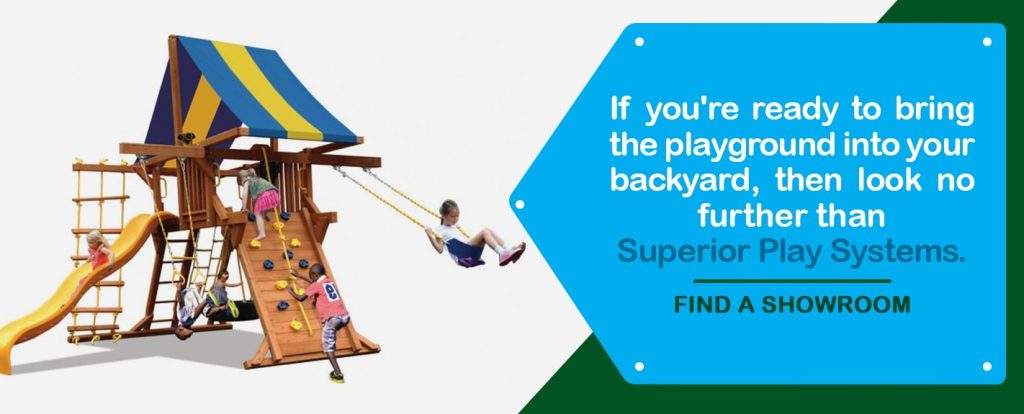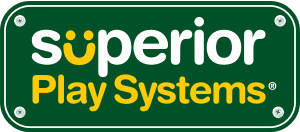The Role of Playsets in Developing Motor Skills, Coordination and Agility
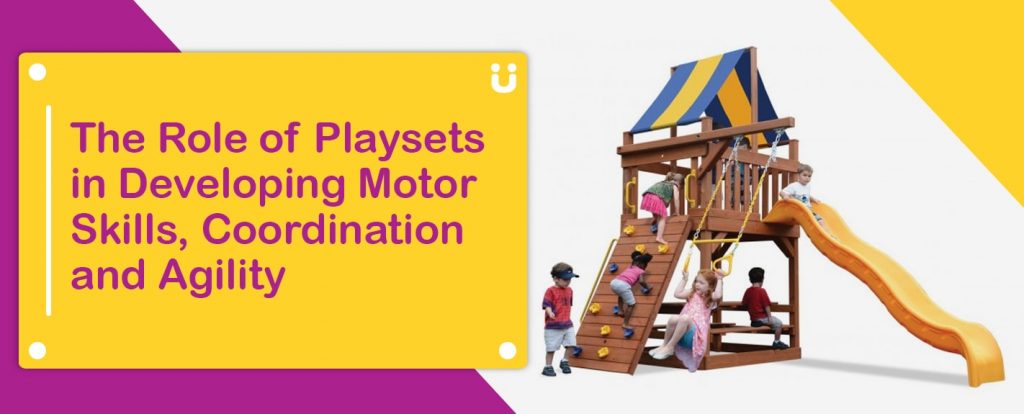
- The Importance of Motor Skill Development in Children
- Gross Motor Skills vs. Fine Motor Skills
- How Playsets Can Improve Motor Skills, Coordination and Agility
- The Best Playsets for Child Development
Have you ever noticed that a lot of playdates happen at the playground? It only takes about five minutes of hanging around a group of parents before you hear them talking about how much they love taking their kids to burn energy at their local park. For most parents, the time spent on a playset — whether at a park or at home — helps to make bedtime a lot easier. After all, a tired kid goes to bed much easier than a child who’s still got energy to spare.
Why do kids get so tired when they are playing?
When children are climbing, sliding and swinging, they are engaging muscles, increasing their heart rate and improving their motor skills. They may not notice it, but their bodies are working hard to handle all of the demands being put on them.
Besides the immediate physical benefits of burning energy, all of the activities children engage in on a playset are also essential to the long-term health and development of children.
What many people don’t realize is that playsets aren’t designed just for fun, although they certainly are that. The importance of play in child development is well-documented. Playsets are intended to help children build their physical abilities and social skills. Children who spend time swinging across the monkey bars, jumping through tunnels and digging in sand are also spending that time improving their motor skills, coordination and agility. They are aiding their body as it grows and develops, improving their health as they head toward adulthood.
The Importance of Motor Skill Development in Children
Have you ever wondered why babies and toddlers sleep so much? Their bodies are hard at work, developing the mental and physical skills that most adults take for granted. It’s hard work for a baby to learn to sit, hold a cup and, eventually, walk. But their development doesn’t stop when they walk. Throughout childhood, kids are developing both gross and fine motor skills. These skills are what allow them to throw a ball, hold a pencil, climb a tree and type on a computer.
Anything we do that requires an action or movement of some kind is a motor skill and is something that our bodies have developed as we grow. While some of these actions may seem to be instinctive — such as a baby’s interest in walking — the truth is that their muscles are working hard to support this development and grow along with their brains that are telling them this is a great new way to be mobile.
As children get older, they become more and more active. And, while it may not seem like sliding or swinging has much value when it comes to physical development, it’s helping your child develop and grow their muscles and movements so that they can do more and be even stronger later.
Gross Motor Skills vs. Fine Motor Skills
The term “motor skills” is used to describe anything related to the body’s ability to move. It encompasses movements of muscles, joints and bones for big movements, such as walking, jumping and running. It also includes smaller actions, such as writing, cutting and tying shoes. Because this category is so broad, it is typically broken down into two specific groups — gross motor skills and fine motor skills.
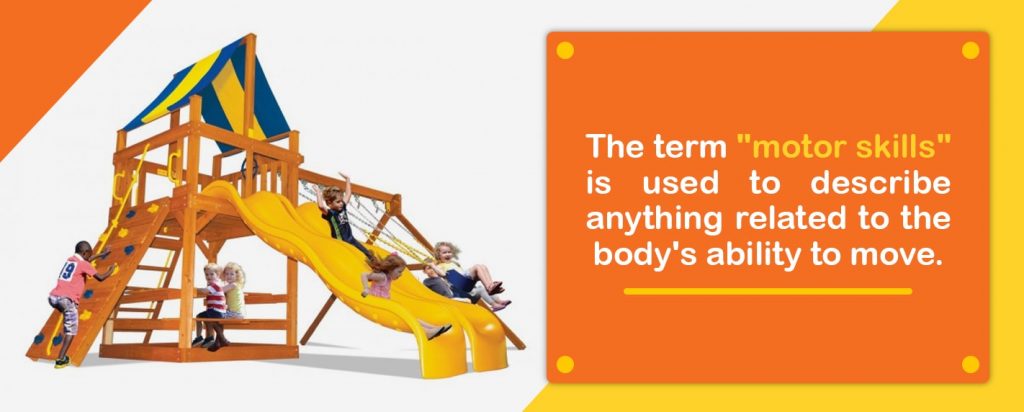
1. Gross Motor Skills
Gross motor skills refer to movements that use the whole body, again such as walking and running. As children grow, so do their muscles. In a younger child, these skills will take the form of sitting up, crawling, walking and running. As children grow, their muscles will develop to the point where they can jump, hop on one foot and ride a bike. Many parents believe that these are simply learned skills, but they are abilities that a child’s body has to develop as they grow.
The transition from riding a tricycle to a bicycle with training wheels to a two-wheeler demonstrates one example of this progression. Yes, their parent may have “taught” them the correct form or ways to move their arms and legs, but this progress is all thanks to the development of gross motor skills as a child grows.
2. Fine Motor Skills
“Fine motor skills” is the term used to refer to a group of more precise movements, typically performed with fingers and hands. When children are toddlers, this development may look like scribbling with a crayon, eating with a fork or building a tower with blocks. As they grow, this skill develops into writing their name, cutting pictures out of magazines and self-care tasks, like tying shoes, zipping a coat or brushing teeth.
Fine motor skills are also closely linked to a child’s central nervous system. The reason these skills develop later is that they cannot fully mature until a child’s central nervous system has grown enough to send signals from the brain to their hands and fingers telling them to push a button, snap their pants or brush their hair. Fine motor skills also require a certain level of gross motor skill progression because they need specific muscle systems to be already built up.
How Playsets Can Improve Motor Skills, Coordination and Agility
While motor skill progression does come with age — children’s muscles grow and develop strength as they get older — it also comes from regular movement and exercise, such as what a child does while playing on a playground. When children are climbing up a ladder, sliding down a slide or taking off on the swings, it may seem like they’re simply playing. But they’re actually developing the motor skills and coordination they need to succeed in everyday life.
What does this look like? Playsets are designed so a child has to climb up platforms or a ladder to reach the top of the slide. Each time they climb, they are strengthing their muscles, preparing them for more activity. Children don’t typically think of actions like this as work because they are having so much fun sliding, but, in a sense, they’re working out while they’re on a playset.
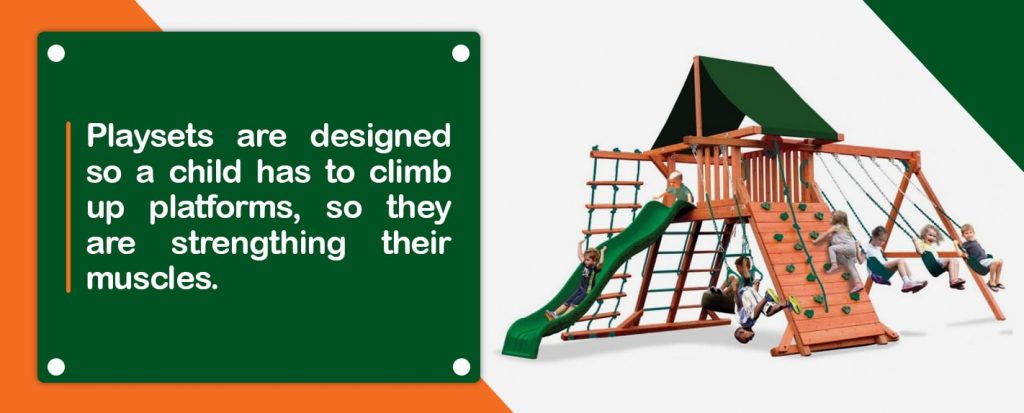
Besides motor skill progression, playsets are also designed to aid children in the development of their coordination. Coordination is the term for a child’s ability to respond to multiple signals from the brain simultaneously signaling them to perform a complex task. For example, catching a baseball requires a child to use their eyes to follow the ball while simultaneously using their hand to reach out and grab the ball before it falls to the ground. That’s two different muscle groups right there — eyes and hands — as well as the brain signals that are being followed.
A child who regularly swings on a playset probably won’t be the next Babe Ruth, but a child who can improve their coordination through play will be more coordinated later, both in athletics and in everyday life when they need to drive a car, clean their house and do numerous other daily tasks that require several muscle systems at the same time.
On a playset, children can learn how to respond to multiple signals at the same time. Swinging, for example, requires a child to simultaneously use their legs and abdominal muscles to make the swing move. Children also have the opportunity to practice seemingly simple tasks like walking and climbing as they climb up to a platform and then walk over to a slide or monkey bars. Practicing these actions over and over again improves the body’s ability to perform these tasks efficiently.
Improved coordination also means improved balance and lower risk of injury — both now and in the future.
The word “agility” refers to a person’s ability to move and change directions quickly in a controlled manner. It’s often heralded in sports, particularly ones like basketball or soccer where players are expected to run quickly and change direction suddenly to follow the ball. If you’ve ever watched children playing on a playset, then it doesn’t take much to understand how a playset can improve a child’s agility. When children are on a playset, they are in constant motion. Up the ladder, down the slide, over to the swings, across the monkey bars — their movement is constant.
Playsets are designed to improve motor skills, coordination and agility. They are also designed to inspire children to play together and create their own fun. Have you ever noticed a group of children running up and down a playset, screaming about being chased by a dragon or a wicked monster? Besides all of the physical activity involved in their game, those children are developing social skills and the imagination they need to succeed later in life.
All because someone wanted their child to burn energy on a playset.
The Best Playsets for Child Development
Sure, you can take your child to the playground from time-to-time, but one of the best ways to build motor skills on the playground is to bring the playground to your backyard. When you purchase a playset for your home, you are investing in your child’s development, helping them improve their motor skills, coordination and agility. Superior Play knows how playsets help child development, and that’s why we’re happy to offer a wide selection of options for all needs and budgets.
One popular model is the Original Fort with 2 Position Swingbeam. This model features a climbing wall that leads up to a small fort. As they climb, children are working on using hand-eye coordination, as well as improving leg strength and flexibility. This model also includes swings, which are known to help children develop their coordination. As children learn how to swing themselves, they also begin to strengthen their core and leg muscles, using them to propel themselves higher and higher.
The Classic Playcenter Combo 2 offers many of the same benefits, but it also features a swing beam and two climbing ladders. A swing beam provides a place for children to swing while hanging from a bar or handles. This allows them to improve their flexibility, as well as upper body strength.
A lot of people don’t realize that sliding also provides major developmental benefits for children. When a child goes down a slide, it stimulates the fluids in their ear canals that are responsible for helping to maintain balance. When children go down a slide, they are learning how to keep their upper body balanced, even as gravity is pulling them down.
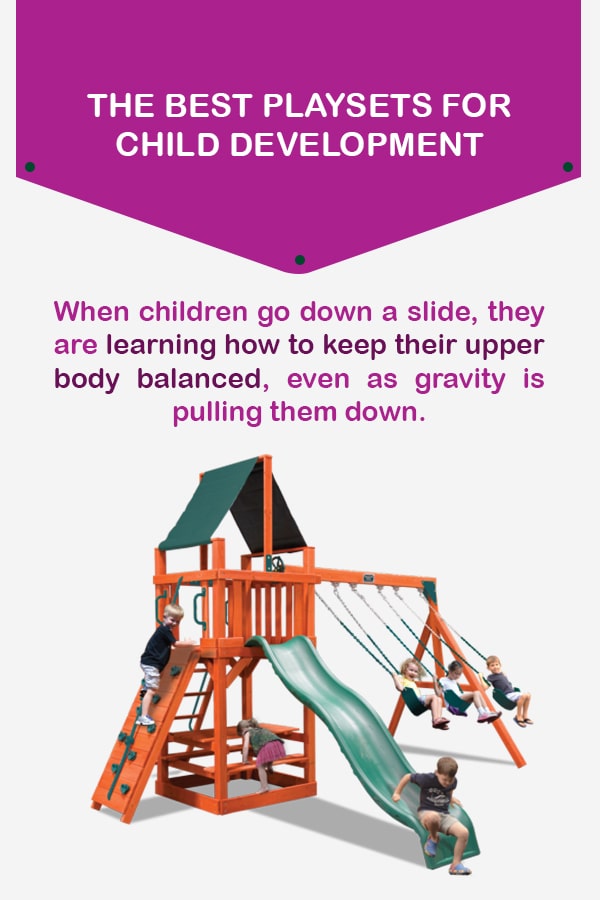
Many of the Superior Play playsets offer a combination of slides, swings and climbing apparatus — all designed to help children grow and strengthen their bodies and their minds.
One advantage of a playset that parents often overlook is the overall benefits of outdoor play to children’s growth. By providing your child with opportunities for self-directed outdoor play, you allow them to create games and scenarios that they can then process through — on their own or with a friend. Children and adults alike also derive a lot of mental benefits from spending time outside. Spending time outdoors has been shown to improve your mood, lower risk of anxiety and depression, and improve focus, all of which make for happier and healthier children — and parents.
Learn More Playsets from Superior Play Systems®
The mental and physical benefits of outdoor play are well-documented. Children who are allowed to spend time in a playground setting — whether in a park or their own backyard — can improve their motor skills, coordination and agility. And they have fun while they’re doing it!
Parents often use the playground as a means for helping their children expend energy, without ever really understanding why their children are so worn out by the time they head home. Now that you know a little bit more about how playsets help child development, give yourself a pat on the back. What you thought you were doing just to preserve your own sanity is actually one of the best things you can do for your child’s overall health and wellbeing.
The occasional visit to a local park is one great way to take advantage of the equipment there, but children who have regular access to a playset in their own backyard have an additional advantage when it comes to motor skill development. The more often they can play on a playset, the more often they can work on their development and coordination. Superior Play Systems® is dedicated to offering state-of-the-art, safe and affordable outdoor playsets for children of all ages.
Our Natural Premium Cedar playsets are 100 percent chemical-free and splinter-free, unlike the pine and North American timber options offered by our competitors. But, what really sets us apart from the competition is that our showrooms are also safe and fun playspaces — the perfect place to try before you buy. With locations in North Carolina, New Jersey, Georgia and Pennsylvania, families come to our showrooms to find the perfect playset, and they do this by running, swinging and climbing on each of our models. In fact, some families even have birthday parties in our showrooms, bringing their family and friends to discover the joys — and benefits — of a high-quality playset.
If you’re ready to bring the playground into your backyard, then look no further than Superior Play Systems®. Find a showroom near you today.
